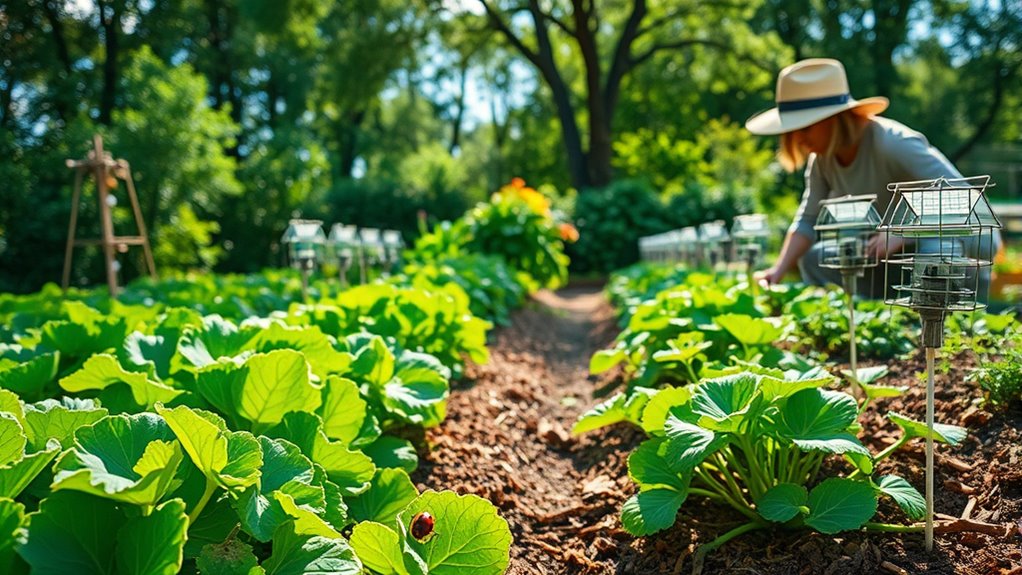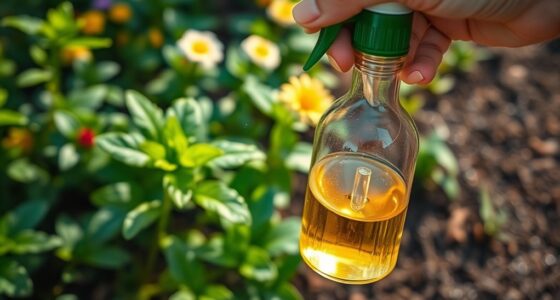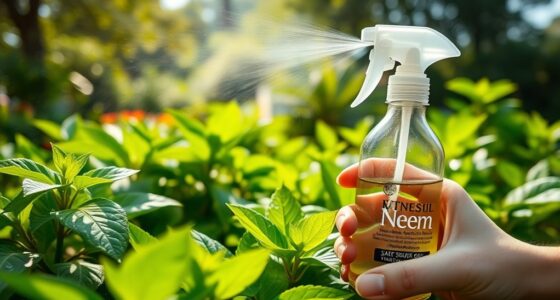Integrated Pest Management (IPM) is a sustainable way for you to control pests by using a combination of methods that protect your garden’s health and minimize environmental impact. It involves monitoring pests closely, identifying them accurately, and using targeted strategies like encouraging natural predators, cultural practices, and selective organic treatments. IPM focuses on preventing problems before they get out of hand. Keep exploring to discover how implementing these techniques can lead to a healthier, more balanced garden environment.
Key Takeaways
- IPM is a sustainable pest control approach that combines biological, cultural, and chemical methods to minimize environmental impact.
- It emphasizes regular monitoring and accurate pest identification to make informed, targeted treatment decisions.
- Control methods are used only when pest populations reach levels that threaten plants, prioritizing natural enemies and organic options.
- IPM reduces reliance on chemical pesticides, protecting beneficial insects and preventing pest resistance.
- Successful implementation requires observation, ecosystem understanding, and a balanced approach for healthy, resilient gardens.

Are you looking for a way to manage pests in your garden without relying heavily on chemicals? If so, integrated pest management (IPM) offers a sustainable approach that balances effective pest control with environmental health. Instead of defaulting to chemical pesticides, IPM emphasizes the use of multiple strategies, including biological control, to keep pest populations under control. Biological control involves introducing or encouraging natural predators, parasites, or pathogens that target specific pests. For example, ladybugs can help reduce aphid populations, and parasitic wasps can control whiteflies. By leveraging these natural enemies, you can considerably reduce your dependence on chemical interventions, leading to pesticide reduction and a healthier garden ecosystem.
Use natural predators like ladybugs and parasitic wasps to control pests and reduce chemical reliance in your garden.
IPM promotes a proactive approach, starting with monitoring and identifying pests accurately. You’ll want to regularly inspect your plants for signs of trouble, noting which pests are present and in what numbers. This step ensures you only take action when necessary, avoiding unnecessary treatments that can harm beneficial insects or pollute the environment. When pest levels reach a threshold that could cause economic or aesthetic damage, you can then select targeted control methods. This might include introducing biological agents, applying organic or selective pesticides, or employing cultural practices like crop rotation or proper watering to make your garden less inviting to pests.
One of the key benefits of IPM is its focus on pesticide reduction. Traditional pest control often relies heavily on chemical pesticides, which can lead to resistance, harm beneficial insects, and contaminate soil and water. IPM encourages minimizing pesticide use by integrating diverse tactics, such as habitat manipulation to attract natural enemies or using resistant plant varieties. When pesticides are necessary, IPM recommends choosing the least toxic options and applying them in a targeted manner to reduce environmental impact. This approach not only protects beneficial insects but also reduces your exposure to potentially harmful chemicals.
Implementing IPM in your garden requires patience and observation, but the rewards are well worth it. You’ll develop a better understanding of your garden’s ecosystem, fostering a balanced environment where pests are kept in check naturally. This method promotes sustainable gardening practices that protect pollinators, beneficial insects, and your soil’s health. Additionally, understanding the role of heat pump efficiency can help you optimize your garden’s microclimate and energy use, indirectly supporting pest management by maintaining healthier plants. By combining biological control, cultural practices, and judicious pesticide use, you can create a resilient garden that stays productive and beautiful while minimizing chemical reliance. Ultimately, IPM empowers you to control pests effectively and responsibly, ensuring your garden remains a thriving, healthy space for years to come.
Frequently Asked Questions
How Does IPM Compare to Traditional Pest Control Methods?
Compared to traditional pest control methods, IPM emphasizes sustainability benefits and cost effectiveness by using targeted strategies rather than blanket pesticide application. You’ll find that IPM minimizes environmental impact, reduces chemical use, and often saves money over time. It encourages monitoring pests closely and employing natural or mechanical controls first, making it a smarter, eco-friendly approach that protects your garden’s health while keeping costs manageable.
Are There Eco-Friendly Pesticides Used in IPM?
Think of eco-friendly pesticides as the gentle giants of pest control. Yes, they exist within IPM, offering natural alternatives that protect your garden without harmful chemicals. These eco-friendly pesticides are derived from natural sources, making them safer for beneficial insects and your environment. They’re part of a sustainable approach, helping you manage pests effectively while minimizing ecological impact. With these options, you’re nurturing a healthier, more balanced garden ecosystem.
Can IPM Be Applied to Organic Gardening?
Absolutely, you can apply IPM to organic gardening. It aligns with organic practices by emphasizing pest suppression through natural methods like biological controls, crop rotation, and habitat management. You actively monitor pest levels and use targeted, eco-friendly solutions when necessary. This approach minimizes chemical use, promotes healthy ecosystems, and effectively manages pests, making it an ideal strategy for organic gardeners seeking sustainable, environmentally conscious pest control.
What Training Is Needed to Implement IPM Effectively?
To implement IPM effectively, you need training in pest identification and monitoring techniques. You’ll learn how to recognize pests early and assess their populations accurately. This knowledge helps you decide when and how to intervene, minimizing chemical use. You might attend workshops, read guides, or consult local extension services. With proper training, you’ll confidently monitor your garden and apply targeted, eco-friendly pest control strategies that protect your plants and environment.
How Long Does It Typically Take to See Results With IPM?
You might see results from IPM within a few weeks, but it varies based on pest severity and the methods used. Pest monitoring helps you track pest activity, while biological control introduces natural enemies to pests. Consistent application of these strategies allows you to gradually reduce pest populations, leading to healthier plants. Patience is key, and you’ll likely notice improvements as you continue implementing IPM practices.
Conclusion
By embracing integrated pest management, you’re wielding a gardening superpower that can transform your garden into a thriving, pest-free paradise. This approach isn’t just effective; it’s like having a secret weapon against pests that’s more powerful than any chemical arsenal. With patience, observation, and smart strategies, you’ll outsmart pests and nurture healthier plants. So, take control today and watch your garden flourish like never before—because with IPM, the possibilities are endless!









